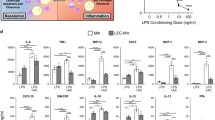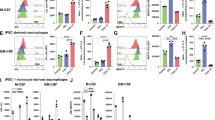Abstract
It has been assumed that apoptosis leads to no production of pro-inflammatory cytokines or the production of anti-inflammatory cytokines in vivo, although the response of macrophages following phagocytosis of apoptotic cells in vivo has not been examined. In this study we therefore examined the response to apoptotic cells in vivo. Injection of apoptotic cells into the peritoneal cavity of mice led to transient neutrophil infiltration and concomitant production of MIP-2, a mouse homologue of IL-8. Apoptotic cells were phagocytosed by macrophages, as revealed on two-color flow cytometric analysis and microscopic observation. When the mice were depleted of macrophages by pretreatment with liposome-encapsulated dichloromethylene bisphosphonate, both neutrophil infiltration and MIP-2 production were significantly suppressed, suggesting that macrophages are required for MIP-2 production in this in vivo response. These results support the hypothesis that extensive apoptosis occurring rapidly may induce an inflammatory response in vivo.
Similar content being viewed by others
References
Steller H. Mechanisms and genes of cellular suicide. Science 1995; 267: 1445-1462.
Hughes J, Liu Y, Van Damme J, Savill J. Human glomerular mesengial cell phagocytosis of apoptotic neutrophils. J Immunol 1997; 158: 4389-4397.
Fadok VA, Bratton DL, Konowel A, Freed PW, Westcott JY, Henson PM. Macrophages that have ingested apoptotic cells in vitro inhibit proinflammatory cytokine production through autocrine/paracrine mechanisms involving TGF-β, PGE2, and PAF. J Clin Invest 1998; 101: 890-898.
Uchimura E, Kodaira T, Kurosaka K, Yang D, Watanabe N, Kobayashi Y. Interaction of phagocytes with apoptotic cells leads to production of pro-inflammatory cytokines. Biochem Biophys Res Commun 1997; 239: 799-803.
Kurosaka K, Watanabe N, Kobayashi Y. Production of pro-inflammatory cytokines by phorbol myristate acetate-treated THP-1 cells and monocyte-derived macrophages after phagocytosis of apoptotic CTLL-2 cells. J Immunol 1998; 161: 6245-6249.
Uchimura E, Watanabe N, Niwa O, Muto M, Kobayashi Y. Transient infiltration of neutrophils into the thymus in association with apoptosis induced by whole-body X-irradiation. J Leukoc Biol 2000; 67: 780-784.
Daemen MARC, van't Veer C, Denecker G, et al. Inhibition of apoptosis induced by ischemia-reperfusion prevents inflammation. J Clin Invest 1999; 104: 541-549.
Sansonetti PJ, Phalipon A, Arondel J, et al. Caspase-1 activation of IL-1β and IL-18 are essential for Shigella flexneri-induced inflammation. Immunity 2000; 12: 581-590.
Miwa K, Asano M, Horai R, Iwakura Y, Nagata S, Suda T. Caspase 1-independent IL-1β release and inflammation induced by the apoptosis inducer Fas ligand. Nat Med 1998; 11: 1287-1292.
Allison J, Georgiou HM, Strasser A, Vaux DL. Transgenic expression of CD95 ligand on islet β cells induces a granulocytic infiltration but does not confer immune privilege upon islet allografts. Proc Natl Acad Sci USA 1997; 94: 3943-3947.
Jaeschke H, Fisher MA, Lawson JA, Simmons CA, Farhood A, Jones DA. Activation of caspase 3 (CPP32)-like proteases is essential for TNF-β-induced hepatic parenchymal cell apoptosis and neutrophil-mediated necrosis in a murine endotoxin shock model. J Immunol 1998; 160: 3480-3486.
Hogaboam CM, Bone-Larson CL, Steinhauser ML, et al. Novel CXCR2-dependent liver regenerative qualities of ELR-containing CXC chemokines. FASEB J 1999; 13: 1565-1574.
Ronchetti A, Rovere P, Lezzi G, et al. Immunogenicity of apoptotic cells in vivo: Role of antigen load, antigen-presenting cells, and cytokines. J Immunol 1999; 163: 130-136.
Gregory CD. CD14-dependent clearance of apoptotic cells: Relevance to the immune system. Curr Opin in Immunol 2000; 12: 27-34.
Taylor PR, Carugati A, Fadok VA, et al. A hierarchical role for classical pathway complement proteins in the clearance of apoptotic cells in vivo. J Exp Med 2000; 192: 359-366.
Naito M, Nagai H, Kawano S, et al. Liposome-encapsulated dichloromethylene diphosphonate induces macrophage apoptosis in vivo and in vitro. J Leukoc Biol 1996; 60: 337-344.
Sonoda Y, Mukaida N, Wang J-b, et al. Physiologic regulation of postovulatory neutrophil migration into vagina in mice by a C-X-C chemokine(s). J Immunol 1998; 160: 6159-6165.
Author information
Authors and Affiliations
Rights and permissions
About this article
Cite this article
Misawa, R., Kawagishi, C., Watanabe, N. et al. Infiltration of neutrophils following injection of apoptotic cells into the peritoneal cavity. Apoptosis 6, 411–417 (2001). https://doi.org/10.1023/A:1012406121993
Issue Date:
DOI: https://doi.org/10.1023/A:1012406121993




